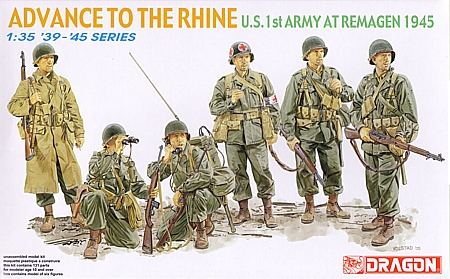| Advance
to the Rhine, U.S. 1st Army at Remagen 1945 |
 |
|
Dragon
Models Limited I predict this set is going to be a big seller for Dragon (I bought three myself) because it gives us a few things we haven't seen before—or rarely—in plastic, and it offers "multipose" possibilities in combination with other figure sets. I've already heard of one person swapping arms with a 101st Airborne figure to allow the GI in the raincoat to carry a Tommy gun. And since the M1943 jacket is common to both regular and parachute infantry, you can mix and match with DML's Varsity figures, or sculpt some cargo pockets for these boys and enlist them straight into the paratroop ranks. Among the new features, we finally have a GI wearing a raincoat. These were popular not just for rain protection but also for warmth in the winter and spring of 1945. (The coat was actually introduced in 1942 and used in North Africa and the Mediterranean as well; just replace the leather gaiters with canvas leggings.) The only other raincoated soldier I'm familiar with is a resin one from Verlinden. As customary with DML sets, the lower lengths of this coat are separate pieces that give a more convincing look than a solid lump encircling the soldier's legs. We now have our first bona fide medic in plastic. He wears the distinctive suspenders with the wide yoke over and around the shoulders for carrying the two large aid pouches. Cross decals are provided for the molded-on armband and helmet. DML also gives us a decent soldier talking on the radio; there was one in Tamiya's ancient combat group set, and resin winter figures from YANKS and Royal Models. Again, this figure could easily be modified to be standing or sitting with a different set of lower legs. Likewise with the figure looking through the binoculars. The other two soldiers are nicely posed for a variety of diorama situations, or handy for conversions. The most notable piece of new equipment, of course, is the SCR-300. This radio measured 10" wide by 15" long and 6"deep. DML's radio is a tad too wide and long, but is the closest to actual dimensions of those radios on the market today (Custom Dioramics and the monster-sized set from Verlinden). The lid and antenna are separate pieces (painting tip: all the knobs on the control panel are black). You'll need to provide the wiring to the handset; the cord is one line until it forks in two about 9" away from the two plug receptacles on the front left side of the panel. A headset for listening could also be plugged into a third receptacle. By the way, the SCR-300 was the device actually nicknamed the "walkie-talkie." The two-way handheld radio we now commonly refer to as a walkie-talkie is actually the SCR-536, which was called a "handy-talkie" by the troops. There is a lot of equipment provided, including the ubiquitous canteens, knives, ammo pouches, etc. The M1943 entrenching tools are holdovers from DML's Normandy Rangers set and needs to have the rings removed from below the carrier as these represent straps from the assault vests. The M6 gas mask carriers provided for five of the figures are each differently sculpted, which is wonderful. However, they're all a bit too stubby than actual carriers. (Soldiers usually discarded the masks and stuffed the carriers with extra clothes, food, or ammo.) Two identical frets of weapons (carbines, Garands, and BARs) are supplied. Be sure to remove the bayonet lug from the carbine since that was a post-war feature. Small Quibble Department: The box art shows three soldiers smoking: raincoat, medic, and bandolier. DML actually supplies cigs for the first two, but not the latter (and it's not called out in the instructions). The cigs are more cigar-sized, and the one for the raincoat man is misnumbered on the sprue. Also, the M6 bag carried by the man in the raincoat should be painted as the others (light or dark OD) rather than the tan that is depicted in the instructions. I have to say that I'm disappointed in the lack of sharpness of details in this set. DML has taken a step backwards from the quality of previous sets. The heads still have the typical blank DML expressions. These figures seem to be cast in the same type of styrene DML has been using for some time, and not the new "second-generation" styrene that makes up the German soldiers in 2005, and none of the gear has the "gee-whiz" quotient that we've seen with these German releases. Finally, I'm kind of surprised Dragon didn't "brand" this box as a 60th anniversary set as it has with others, since the Remagen action was in 1945. So this very good and welcomed set will please most, if not all, GI modelers. For years I've been calling on manufactures to do simple things, like sculpting distinctly different equipment as DML has finally done with the M6 carriers, or give us figures like medics and radio operators. It may take a while, but some of them respond and brighten our modeling world. -tss- |
 |
 |
 |
 |
 |
 |
 |
 |
 |
 |
 |
 |
|
